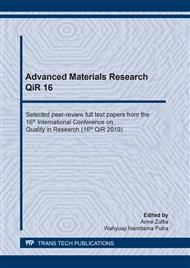[1]
J. K. Wessel. (2004). Handbook of Advanced Materials, John Wiley & Sons, Inc., New Jersey. Pp. 321.
Google Scholar
[2]
S. Shankar, D. Apelian. (2002). Die soldering: Mechanism of the Interface Reaction between Molten Aluminum Alloy and Tool Steel. Metallurgical and Materials Transactions B-Process Metallurgy and Materials Processing Science, 33(3). Pp.465-476.
DOI: 10.1007/s11663-002-0057-7
Google Scholar
[3]
V. Joshi, Srivastava, A., Shivpuri, R. (2003). Investigating ion nitriding for the reductionof dissolution and soldering in die-casting shot sleeves, Surface and CoatingsTechnology, vol. 163-164, pp.668-673.
DOI: 10.1016/s0257-8972(02)00693-x
Google Scholar
[4]
A. Noorian, Sh. Kheirandish, H. Saghafian. (2010). Evaluation of the mechanical properties of niobium modified cast AISI H 13 hot work tool steel. Iranian Journal of Materials Science and Engineering, Vol. 7, no. 2, pp.22-29.
Google Scholar
[5]
S. Shankar, and D. Apelian. (2002). Mechanism and Preventive Measures for Die Soldering during Al Casting in a Ferrous Mold. Journal of Materials, pp.47-54.
DOI: 10.1007/bf02711867
Google Scholar
[6]
Z.W. Chen, and M.Z. Jahedi, Die Erosion and Its Effect on Soldering Formation in High Pressure Die Casting of Aluminum Alloys,, Journal of Materials and Design, 1999, pp.303-309.
DOI: 10.1016/s0261-3069(99)00035-7
Google Scholar
[7]
D. Pye, Practical Nitriding and Ferritic Nitrocarburizing,, ASM International. The Materials Information Society. United States of America: Library Congress cataloging in Publication Data, 2003, pp.1-183.
Google Scholar
[8]
Q Han, and S Viswanathan, Analysis of the Mechanism of Die Soldering in Aluminum Die Casting,, Metallurgical and Materials Transactions A, vol. 34A, 2003, pp.139-146.
DOI: 10.1007/s11661-003-0215-9
Google Scholar
[9]
Z W Chen, Formation and progression of die soldering during high pressure die casting,, Materials Science and Engineering: A, vol. 397, no. 1-2, 2005, pp.356-369.
DOI: 10.1016/j.msea.2005.02.057
Google Scholar
[10]
ASM Metal Handbook 10th Edition Vol. 01: Properties and Selection Irons Steels and High- Performance Alloys, pp.1840-1868.
Google Scholar
[11]
M. Sean, and A. Fatemi, Influence of Surface Finish on Fatigue Behavior of Forged Steel Including Heating Method, Hardness, and Shot Cleaning Effects, FIERF, AISI, University of Toledo, (2011).
Google Scholar
[12]
H R Shahverdia, M R Ghomashchib, S Shabestaric, and J Hejazic, Microstructural analysis of interfacial reaction between molten aluminium and solid iron,, Journal of Materials Processing Technology, vol. 124, 2002, pp.345-352.
DOI: 10.1016/s0924-0136(02)00225-x
Google Scholar
[13]
S-H Chang, S-C Lee, and T-P Tang, Effect of Shot Peening Treatment on Forging Die Life,, Materials Transactions, vol. 49, no. 3, 2008, pp.619-623.
DOI: 10.2320/matertrans.mer2007622
Google Scholar
[14]
V Joshi, A Srivastava, and R Shivpuri, Intermetallic formation and its relation to interface mass loss and tribology in die casting dies,, Wear, vol. 256, no. 11-12, 2004, pp.1232-1235.
DOI: 10.1016/j.wear.2003.08.001
Google Scholar
[15]
Z D Xiang, Shot peening effect on aluminide diffusion coating formation on alloy steels at low temperatures,, Scripta Materialia, vol. 55, 2006, pp.1151-1154.
DOI: 10.1016/j.scriptamat.2006.08.016
Google Scholar
[16]
Q Han, and S Viswanathan, Analysis of the Mechanism of Die Soldering in Aluminum Die Casting,, Metallurgical and Materials Transactions A, vol. 34A, 2003, pp.139-146.
DOI: 10.1007/s11661-003-0215-9
Google Scholar


